Are Wooden Pickleball Paddles Good? The 2025 Ultimate Guide for Smart Buyers

CEO & Technical Expert at Pickleball Equipment Company (Art Pickleball)
Specialize in manufacturing pickleball paddles, pickleball balls, and pickleball accessories.
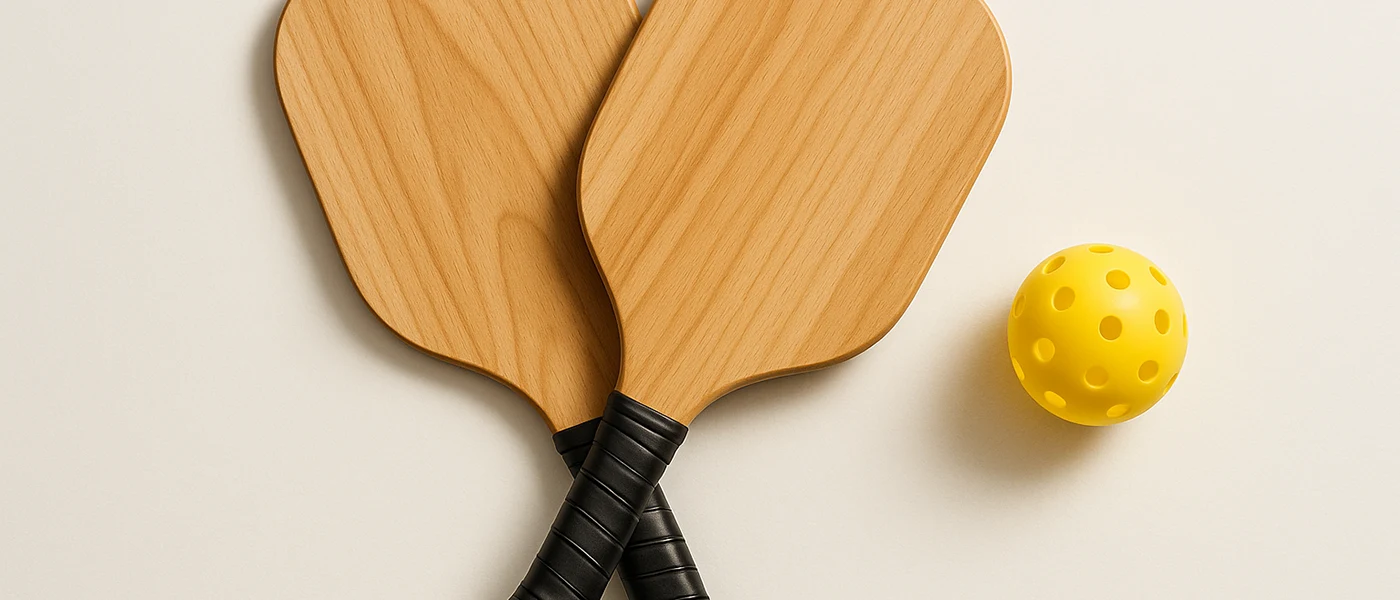
- What Are Wooden Pickleball Paddles?
- Pros of Wooden Pickleball Paddles
- Cons of Wooden Pickleball Paddles
- Wooden vs Composite Paddles: Full Comparison Table
- Who Should Use Wooden Pickleball Paddles?
- Use Cases and Success Stories
- Maintenance & Best Practices for Wooden Paddles
- Buyers’ Guide: Wholesale & Custom Wooden Paddle Orders
- Conclusion
- FAQs – Wooden Paddles: Your Questions Answered
When choosing a pickleball paddle, there’s one classic option that always sparks debate—wooden paddles.
Once the only paddle material in the game, wooden paddles are now often seen as outdated, heavy, and suitable only for beginners.
But here’s the real question:
Are wooden pickleball paddles still a good choice today? And if so, for whom?
In this ultimate guide, we’ll break it all down.
At Art Pickleball, we’ve worked with sports retailers, training camps, and institutional buyers across the world to supply professional-grade pickleball equipment. Based on our industry expertise and customer feedback, this guide will help you:
- Understand the real pros and cons of wooden paddles
- See how they compare with composite or carbon fiber paddles
- Learn who they’re best suited for—whether it’s school programs, training facilities, or budget-sensitive buyers
- Discover how wooden paddles can still provide unbeatable value in specific B2B settings
Whether you’re looking to buy in bulk, customise paddles with your own branding, or just want to make an informed decision for your organisation, you’re in the right place.
Let’s find out if wooden pickleball paddles are the smart choice—for your players, your budget, and your brand.
What Are Wooden Pickleball Paddles?
Wooden pickleball paddles are exactly what they sound like—paddles made primarily from solid or layered wood, often finished with a grip and sometimes a protective edge.
They were the first type of paddle ever used when pickleball was invented in 1965, and they’ve stayed in the game ever since—though the materials and build quality have evolved significantly.
Structure & Materials
Most wooden paddles today are made from multiple layers of plywood or hardwood pressed together for added strength. Unlike modern composite paddles, which feature a polymer honeycomb core and a fiberglass or carbon fiber face, wooden paddles have a solid face with no internal core.
This gives them a distinctively firm and heavy feel, which can be both a strength and a limitation depending on the player’s needs.
Typical construction includes:
- 7-ply or 9-ply hardwood layers (often maple or birch)
- Wrapped handles with either basic tape or synthetic grips
- Optional edge guard or beveled corners for extra durability
- No core cutout—the entire paddle face is solid wood
Compared to synthetic materials, solid wood paddles may also offer a lower carbon footprint, depending on sourcing and production. Many manufacturers highlight that wooden sports equipment biodegrades naturally and leaves minimal long-term waste compared to composites; see the benefits of wooden sports equipment: Unleashing the Power of Nature for more details on this sustainability perspective.
Common Weight Range
Wooden paddles are noticeably heavier than their modern counterparts.
Most fall in the range of 9 to 12+ ounces (255g to 340g).
By contrast, composite paddles usually range from 6.5 to 8.5 ounces.
This added weight gives wooden paddles more power on contact, but can cause faster fatigue during long rallies or fast-paced play.
Historical Role & Modern Adaptation
When pickleball was first played in the 1960s, all paddles were wooden.
Over time, technology introduced lighter, more responsive materials, leading to the development of polymer cores, textured faces, and aerodynamic shapes.
That said, wooden paddles have never disappeared.
Instead, they’ve found a niche in specific markets:
- Schools and youth programs for training
- Community centers for casual or public paddle sharing
- Budget-friendly retail sets for beginners
- Retro enthusiasts who enjoy the feel of traditional gear
Today’s wooden paddles may still look simple, but many now feature:
- Improved finishing and lamination
- Custom branding and print options
- Comfort-focused grips
- Better edge protection
Why Do Wooden Paddles Still Exist?
Because they work—within the right context.
While not ideal for competitive or advanced play, wooden paddles offer:
- Unmatched durability
- Low unit cost for bulk orders
- Simple, reliable construction
- Great entry-level performance for new or casual players
In short, they remain a valuable tool in the pickleball world—especially for schools, training programs, and buyers looking to maximise value at scale.
Pros of Wooden Pickleball Paddles
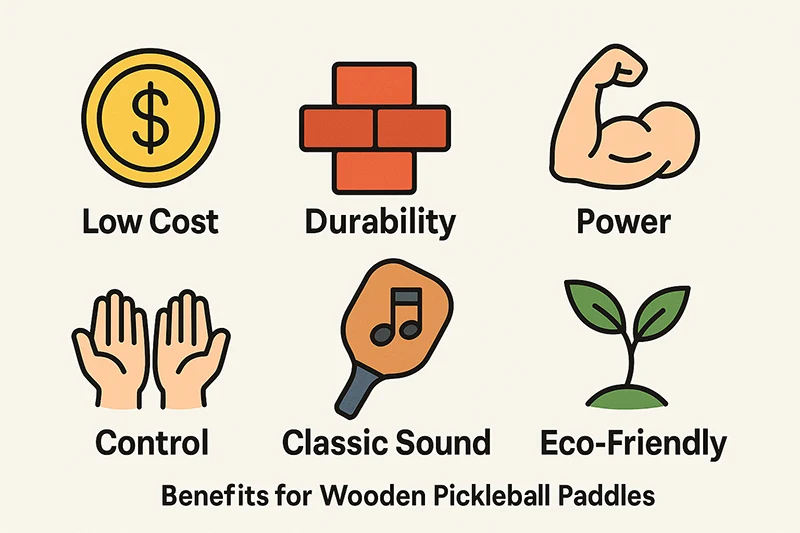
Wooden paddles may seem old-school—but they still offer real advantages in the right settings. Let’s break down the key benefits of wooden pickleball paddles, especially for bulk buyers, trainers, and entry-level players.
1. Lowest Cost Entry Point for Beginners
Wooden paddles are the most affordable option on the market, making them perfect for players trying the sport for the first time.
A typical wooden paddle costs only a fraction of what composite or carbon fiber models do—often under $25 retail, and even less when purchased in bulk.
This low entry cost:
- Encourages more people to try pickleball
- Reduces hesitation for new players
- Makes it easier for parents, clubs, and schools to equip larger groups without blowing the budget
2. Durability and Long Lifespan
Built from layered hardwood or solid plywood, wooden paddles are surprisingly rugged.
They can withstand:
- Drops
- Bumps
- Daily use in high-traffic environments
Unlike composite paddles, which can crack or delaminate, wooden paddles hold up well over time. For schools, community centers, and recreational programs, this means less frequent replacements and lower lifetime cost.
3. Heavy = Powerful Baseline Shots
Because they’re heavier (typically 9–12+ oz), wooden paddles generate more momentum and force when swinging from the baseline.
For players who like to hit with power—or coaches training students to build swing strength—this can be an advantage.
Some coaches even use wooden paddles as resistance tools for training forearm strength and shot stability.
4. Stable and Predictable Control
The solid wooden face offers a consistent hitting surface, giving players a more forgiving and predictable feel—especially during dinks and blocks.
New players often find wooden paddles helpful for:
- Learning how to control pace
- Practicing proper contact point
- Building confidence in their strokes
Without too much “pop” from polymer cores, wooden paddles let you focus on technique over spin.
5. Nostalgic Feel & Classic Sound
There’s a charm to playing pickleball with wood.
The distinct “thock” sound, the natural grain finish, and the old-school feel all contribute to a nostalgic playing experience that some players truly enjoy.
For community clubs, retro-themed tournaments, or teaching the game’s history, wooden paddles add a layer of cultural authenticity.
6. (Optional) Eco-Friendly and Natural Material
Wood is a natural and biodegradable material, which gives wooden paddles a sustainability edge over synthetic alternatives.
If responsibly sourced:
- They require less plastic and resin
- Offer a lower carbon footprint during production
- May appeal to eco-conscious buyers, schools, or CSR-aligned programs
While not always a deal-breaker, sustainability is becoming a value-added factor in institutional and branded gear decisions.
7. Ideal for Group Use in Schools / Clubs
Need to equip a full PE class or community pickleball program?
Wooden paddles are:
- Affordable enough to purchase in bulk
- Durable enough to survive heavy, daily use
- Easy to label, customise, or replace
This makes them perfect for:
- Schools
- Youth training camps
- YMCA and club programs
- One-off tournaments or seasonal leagues
At Art Pickleball, we specialise in wholesale wooden paddles with custom branding, starting at MOQ 100 units. Designed for institutions that need reliable performance at scale.
Wooden paddles aren’t built for pro-level play—but when it comes to accessibility, affordability, and durability, they remain a smart, purpose-fit choice for many groups and players.
Cons of Wooden Pickleball Paddles
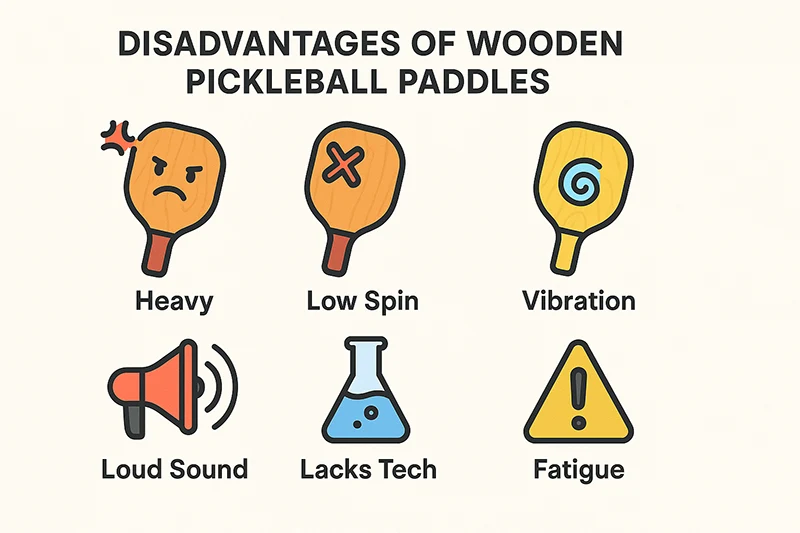
While wooden paddles offer solid value in the right context, they do come with notable limitations—especially when compared to today’s high-performance paddle materials. Here are the key drawbacks to consider:
1. Heavier Than Modern Paddles – Can Cause Fatigue
Most wooden paddles weigh between 9–12+ ounces, which is significantly heavier than composite paddles (typically 6.5–8.5 oz).
This extra weight can:
- Slow down reaction time, especially at the net
- Make quick volleys and resets more difficult
- Lead to wrist and shoulder fatigue during long sessions
For younger players, seniors, or anyone with joint sensitivity, the added mass can be a dealbreaker. It’s important to consider paddle weight relative to your audience’s strength and playing style.
In school or club settings, prolonged use of heavy paddles without proper form may increase injury risk.
2. Low Spin and Limited Ball Control
Wooden paddles have a smooth, flat surface with no texture or tack, and they lack the core rebound found in composite models.
That means:
- Difficult to generate topspin, slice, or cut shots
- Limited touch control for advanced dinking or angled returns
- Smaller and less responsive sweet spot
For players who rely on finesse, precision, or advanced ball manipulation, wooden paddles can feel rigid and one-dimensional.
Wooden paddles are better for learning the basics—not for mastering technical skills like spin or feathered drop shots.
3. Poor Shock Absorption / Hand Vibration
Unlike polymer or aluminum-core paddles that absorb impact, wooden paddles are stiff and unforgiving.
What that means for the player:
- More vibration travels to the hand and forearm
- Off-center hits feel jarring
- Not ideal for anyone recovering from tennis elbow or wrist strain
Over time, repeated impact without damping can lead to discomfort or micro-injuries, especially for beginners with inconsistent stroke mechanics.
4. Louder Hitting Sound
Wooden paddles make a distinct “pop” or “crack” when striking the ball—a sound some find satisfying, but others find distracting.
Compared to the muted thud of composite paddles, the wooden “thock” is:
- Sharper
- Carries further
- More likely to annoy neighbours in indoor gyms or quiet residential courts
In noise-sensitive environments, wooden paddles may not be welcomed—or may need to be paired with quiet balls to reduce impact.
5. Lacks Modern Features (No honeycomb core, edge guards, tech coating)
Wooden paddles don’t include many of the performance-enhancing technologies seen in modern designs. That includes:
- No honeycomb core → less rebound and lower ball speed
- No edge guard → more vulnerable to splitting on impact
- No textured surface → reduced spin potential
- Limited grip comfort → cheaper handle materials = less sweat absorption
While some premium wooden paddles offer slight upgrades, the majority are built for basic use, not elite play.
In other words: they’re designed to be functional, not flashy.
Wooden paddles aren’t made to compete with advanced gear—and that’s okay. For entry-level use, they offer reliability and value. But if you’re aiming for high control, speed, spin, and comfort, it’s worth considering an upgrade to composite or carbon fiber paddles.
Wooden vs Composite Paddles: Full Comparison Table
Trying to decide between a classic wooden paddle and a modern composite one?
Here’s a side-by-side comparison across 10 key factors to help you understand how they differ—and which one is the better fit for your needs.
| Feature | Wooden Paddle | Composite Paddle |
|---|---|---|
| Weight | Heavy (9–12+ oz) | Lightweight (6.5–8.5 oz) |
| Power | Strong from baseline (via mass) | Power via rebound and face tech |
| Control | Basic control, lower finesse | High precision with better touch feel |
| Spin Potential | Low (smooth face) | High (textured face + responsive surface) |
| Sweet Spot Size | Small to medium | Medium to large (more forgiving) |
| Durability | Very durable for everyday use | Durable, but core/face can wear over time |
| Cost per Unit | Low (bulk-friendly) | Moderate to high |
| Competitive Suitability | Not ideal for high-level play | Preferred by advanced and tournament players |
| Sound Level | Loud and sharp | Softer, lower-pitched impact sound |
| Eco Impact | Natural wood (lower carbon footprint) | Synthetic materials, less eco-friendly |
Quick Analysis
Wooden paddles are best suited for:
- Entry-level training
- Budget-limited programs
- Durable group equipment for schools, camps, and community centers
Composite paddles are the better choice for:
- Competitive players
- Those seeking better spin, control, and lighter feel
- Long-term personal investment in performance gear
Pro tip for bulk buyers: Wooden paddles can serve as a reliable starting point in any program. Many of our clients use them for new player onboarding, while offering composite paddles as upgrades later in the player journey.
Who Should Use Wooden Pickleball Paddles?
Wooden pickleball paddles aren’t for everyone—but in the right hands, they’re a practical, cost-effective solution. Let’s break down exactly who benefits from using wooden paddles—and who might want to look elsewhere.
Beginners & New Learners
If you’re just starting out, a wooden paddle is a low-risk, high-value entry point.
- Affordable enough for casual tryouts
- Durable enough to survive early mistakes
- Great for learning paddle grip, timing, and basic shots
- Slower pace = more control for skill development
Many coaches recommend wooden paddles for the first 10–20 sessions before upgrading.
Casual / Recreational Players
Not every player wants to compete.
For those playing at home, parks, or weekend leagues, wooden paddles offer:
- Solid performance at a fraction of the cost
- No worries if the paddle gets scratched, dropped, or borrowed
- A nostalgic feel that matches the fun, laid-back vibe of rec games
Perfect for couples, families, or social players who just want to have a good time.
Schools & Training Camps (Bulk Orders)
This is where wooden paddles shine.
- Affordable at scale for classrooms and club rosters
- Rugged enough to withstand daily use and student handling
- Easy to label, stack, clean, and replace
- Great for standardised instruction—everyone uses the same gear
At Art Pickleball, we supply custom-branded wooden paddles (MOQ 100 units) to schools, summer camps, and PE programs globally.
Budget-Conscious Buyers / One-Time Events
Running a tournament? Hosting a team-building event? Outfitting a seasonal training program?
Wooden paddles help you:
- Keep costs down without compromising basic performance
- Provide gear for 30, 50, or 100+ people at once
- Avoid overspending on gear that might only be used a few times
They’re perfect for:
- Event rental kits
- Temporary outdoor courts
- Club giveaways or prize packages
Power-Oriented Players (Who Like Heavier Paddles)
Some players prefer paddles with more “punch”—and wooden paddles deliver.
- The extra mass helps generate deeper, stronger baseline shots
- Great for players who swing hard and like to hit flat drives
- Also useful in resistance training to build arm strength and control
Caution: These paddles aren’t ideal for speed, spin, or net duels—but for power hitters, they offer raw force at low cost.
Eco-Minded Organizations
Looking for a greener gear solution?
Wooden paddles use natural materials and fewer synthetic composites, making them a good fit for:
- Eco-focused schools
- Sustainable sports initiatives
- Brands building “green” product lines
While not 100% carbon neutral, they’re a lower-impact option than fiberglass or carbon-based alternatives.
If you’re competing at a high level—or training to be—you’ll likely outgrow a wooden paddle fast.
Why?
- Less spin potential
- Smaller sweet spot
- Slower reaction time
- Poorer shock absorption
For tournament-level control, precision, and performance, composite paddles are the standard.
Think of wooden paddles as starter tools—great for learning, but not built for elite execution.
If you prioritise affordability, toughness, and simplicity, wooden paddles make perfect sense.
If you need lightweight precision and spin for fast-paced play, it’s time to explore composite models.
Use Cases and Success Stories
While specs and stats matter, sometimes the best way to understand the value of a paddle is through real-world experience.
Here are two success stories that show where wooden pickleball paddles truly shine—not in theory, but in practice.
Case 1: Coaching Beginners in a Youth Training Camp
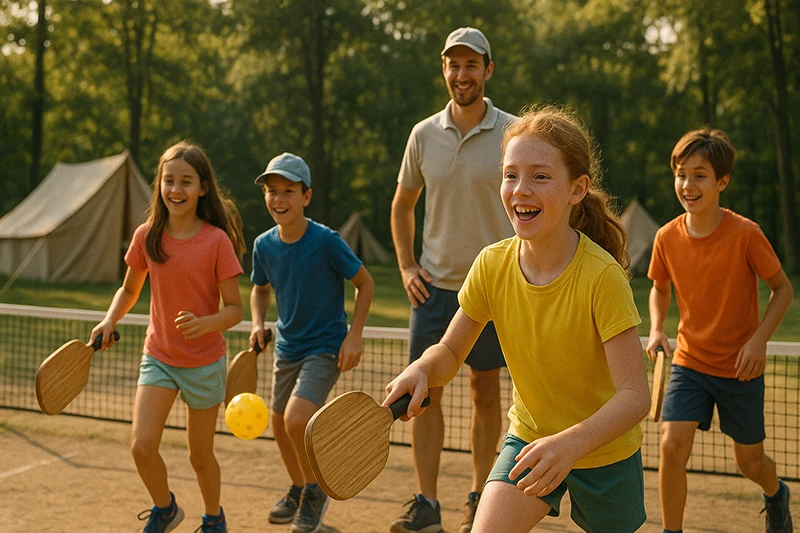
Coach Alyssa runs a summer pickleball camp for kids aged 9–14. Her biggest challenge?
Every week, 30 new students… with zero paddle experience.
Instead of investing in expensive gear that might get dropped, lost, or scuffed, she equips her sessions with bulk wooden paddles.
“They’re tough, cheap, and perfect for learning grip and control. My students can focus on technique without worrying about breaking something expensive.”
The slight heaviness of the paddles also helps her students:
- Build swing strength
- Develop proper follow-through
- Learn at a manageable pace
After 3–4 weeks of progress, advanced kids get a chance to test composite paddles—but they all start with wood.
Case 2: School PE Programs Save Big with Bulk Wood Orders
Lincoln Middle School added pickleball to its PE curriculum. The department needed 40+ paddles, but had a tight budget.
They reached out to Art Pickleball and ordered a wholesale batch of custom wooden paddles (MOQ 100).
Each paddle was printed with the school logo and colour-coded by class group.
“Compared to composite options, we saved over 65% on our gear budget. Plus, we haven’t had to replace a single paddle all semester.”
The wooden paddles:
- Handled daily use from 200+ students
- Survived drops, scuffs, and rainy gym floors
- Helped the school launch an annual pickleball tournament—without overspending
For many schools and institutions, it’s the difference between offering the program or not offering it at all.
What These Stories Teach Us
All these cases share one theme:
The best paddle is the one that fits your purpose.
Wooden paddles aren’t for everyone—but in the hands of a coach, a PE teacher, or even a determined underdog, they get the job done.
That’s why we continue to support them—not just as budget gear, but as tools that make pickleball more accessible, inclusive, and fun.
Maintenance & Best Practices for Wooden Paddles
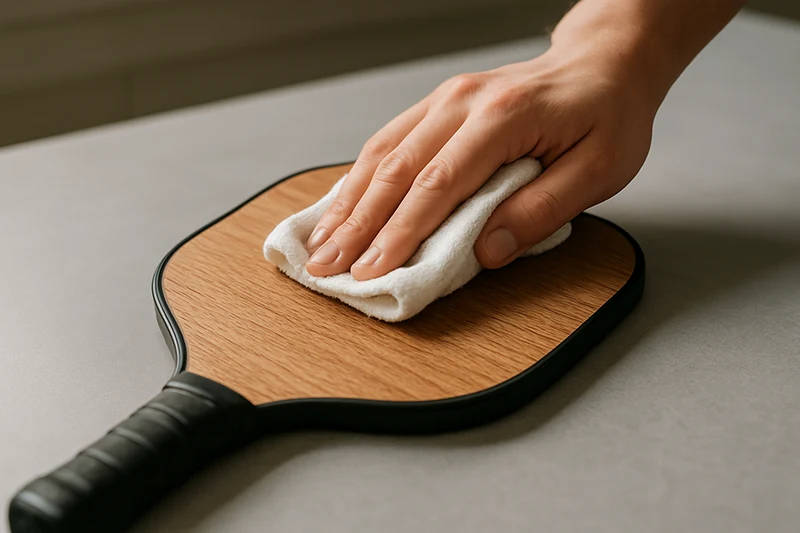
Wooden pickleball paddles are tough—but like any equipment, they last longer with proper care.
Here’s how to keep your wooden paddles performing well and avoid common mistakes that can shorten their lifespan.
1. Clean After Every Use
Wipe down the paddle face with a soft, dry or slightly damp cloth
Avoid harsh chemicals—just warm water is enough for most dirt or smudges
Dry immediately after cleaning to avoid moisture damage
Pro tip: Add a few drops of gentle soap to a microfiber cloth for stubborn scuffs, but always keep the paddle dry afterward.
2. Store in a Cool, Dry Place
Wood is a natural material—and that means it reacts to its environment.
To prevent warping, cracking, or delamination:
- Store paddles away from direct sunlight and heat sources
- Keep them indoors in low humidity, ideally inside a paddle bag or rack
- Never leave paddles in cars, damp basements, or outdoor sheds
Warning: Exposure to high humidity or water can cause the wood to swell, split, or lose shape. Once warped, wooden paddles are difficult to repair.
3. Reduce Vibration with DIY Upgrades
Wooden paddles don’t have built-in shock absorption—but you can improve comfort with a few quick fixes:
- Use a cushioned or perforated overgrip to reduce hand vibration
- Add grip tape or anti-slip wrap for better handling and sweat absorption
- Apply edge guard tape (or PVC trim) to protect the paddle’s sides from chipping
- For heavier vibration, insert a thin rubber sheet under the grip wrap—a trick some tennis players use to ease impact on joints
These small additions can make a big difference, especially for kids or players with sensitive wrists.
4. Know the Expected Lifespan
With proper care, a wooden paddle can last several years—especially in low-intensity or shared-use settings.
But watch out for:
- Splintering or frayed edges
- Surface warping
- Loose handles or rattling inside the grip
When you notice these, it may be time to replace. Still, compared to composite paddles (which often wear faster under stress), wooden paddles offer excellent long-term value, particularly in bulk-use environments.
5. Don’t Play in Wet Conditions
This is a golden rule for wooden gear:
Never use wooden paddles in the rain, on wet courts, or during humid indoor sessions without ventilation.
Why?
- Moisture seeps into the wood grain and weakens the structure
- Paint or sealant can bubble or peel
- Long-term exposure to dampness causes irreversible warping
If your paddle gets wet:
- Dry it immediately with a towel
- Let it air out in a cool, dry room (never near a heater)
- Store it upright or hang it to avoid pressure warping
A little care goes a long way.
By cleaning, storing, and upgrading your wooden paddle correctly, you’ll extend its lifespan, maintain performance, and maximise your investment—whether you’re buying one or one hundred.
Buyers’ Guide: Wholesale & Custom Wooden Paddle Orders
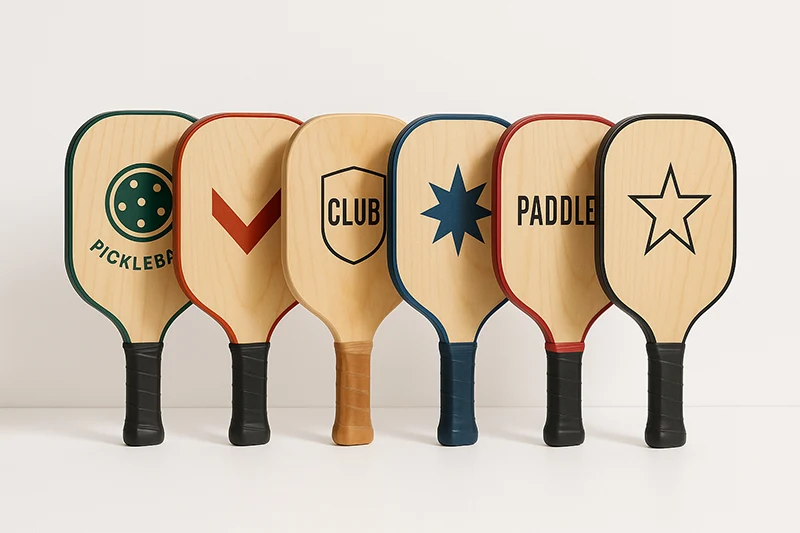
If you’re a school, camp, training academy, sports retailer, or event organiser, chances are you’re not buying just one paddle—you’re sourcing dozens or even hundreds.
This section is for you.
At Art Pickleball, we help institutions worldwide simplify procurement and scale smarter with reliable, custom wooden paddles built for bulk use.
Here’s how it works—and why top organisations choose us as their supplier.
MOQ 100 Units per SKU – Built for Serious Buyers
We specialise in B2B orders and offer a minimum order quantity (MOQ) of 100 units per SKU.
This allows us to:
- Maintain consistent quality across large batches
- Offer competitive wholesale pricing
- Ensure production efficiency and fast turnarounds
Need 300 paddles with 3 grip styles? Or 100 units each in different school colours? We handle it.
Custom Printing & Branding Options
Stand out with paddles that reflect your organisation or brand.
We offer:
- Full-surface logo printing (UV or screen printing)
- Custom colour schemes to match team uniforms or event branding
- Optional surface finishes (matte, gloss, or raw wood)
- Edge wrap colours and handle grip branding available on request
Whether you’re running a youth league or building your own paddle brand, we make sure your gear looks the part.
Product Spec Options for Performance & Feel
All wooden paddles aren’t created equal.
We help you choose the right configuration for your players.
Customisable options include:
- Weight range (light: ~8.5 oz / standard: ~10 oz / heavy: ~12 oz)
- Handle grip size & texture (thin grip, tacky grip, perforated overgrips)
- Edge protection (with or without edge guard tape)
- Wrist straps or bag bundles available upon request
Our team can recommend specs based on player age group, skill level, and use scenario.
Shipping & Lead Time: What to Expect
We ship worldwide with flexible logistics options.
- Standard lead time: ~15–25 working days from artwork approval (for orders under 1,000 units)
- Rush orders available upon request
- Packaging: bulk or retail-ready options
- Shipping methods: sea freight, air freight, express door-to-door
- Customs support provided for international buyers
We’ll work closely with your procurement timeline and event dates to deliver on schedule.
Why Institutions Trust Art Pickleball
- Over 10 years in paddle manufacturing
- In-house design & QA team to ensure batch consistency
- Experience working with schools, clubs, YMCAs, retailers, and tournament hosts
- Responsive English-speaking sales support
- Competitive OEM pricing + flexible branding packages
Our goal isn’t just to sell you paddles—it’s to make paddle sourcing painless.
Many of our clients start with a single order… and return year after year. We’ll help you do it right the first time.
Ready to Get Started?
Let us quote your next project.
👉 Get Your Wholesale Quote Today
Fast response. Flexible options. Low minimums. No guesswork.
Conclusion
In 2025, wooden pickleball paddles are still worth it—when used for the right purpose. They’re affordable, durable, and perfect for beginners, schools, and group training environments. While they can’t match composite paddles in spin, control, or pro-level performance, they remain a smart, budget-friendly tool for foundational play. At Art Pickleball, we help buyers customise wooden paddles that fit their goals and scale.
FAQs – Wooden Paddles: Your Questions Answered
Have more questions before making a decision?
Here are the most common things people ask about wooden pickleball paddles—answered by our experts.
Q1. Are wooden pickleball paddles good for beginners?
Yes. Wooden paddles are a great entry point for new players thanks to their low cost, durability, and simple feel. They’re perfect for learning basic strokes, grip, and timing—especially in schools or community programs.
Q2. Can I use a wooden paddle in a tournament?
Technically, yes — as long as the paddle meets USA Pickleball paddle specifications on size and surface materials.
However, most competitive players prefer composite paddles for better control, spin, and responsiveness. Wooden paddles are rarely seen at advanced levels.
Q3. How much do wooden paddles weigh?
Most wooden paddles weigh between 9 to 12+ ounces, which is heavier than modern composite paddles. The extra weight can deliver more power, but may also cause fatigue over long sessions.
Q4. Why do wooden paddles make more noise?
The solid wood face produces a sharp, loud “pop” when striking the ball. Unlike polymer-core paddles that absorb some sound, wooden paddles reflect more energy into the air—creating a noticeable sound signature.
Q5. How do wooden paddles compare in power?
Wooden paddles generate power through mass, not rebound. That means strong baseline shots are possible—but you’ll need to swing harder. Composite paddles use core technology to generate power more efficiently.
Q6. Will a wooden paddle hurt my arm?
They can cause discomfort over time, especially if you’re prone to tennis elbow or wrist issues. Wooden paddles lack shock absorption, so off-center hits may send more vibration to your arm.
Using cushioned grips and proper technique can help.
Q7. Are there quiet versions of wooden paddles?
Not truly—but you can reduce impact noise slightly by using quiet balls or adding edge tape and softer grips. That said, wooden paddles will always sound louder than honeycomb-core paddles due to their solid construction.
Q8. How long do wooden paddles last?
With proper care, wooden paddles can last several years—especially in low-intensity settings like schools or rec centers. Keep them dry, avoid drops, and store in a cool indoor place to extend lifespan.
